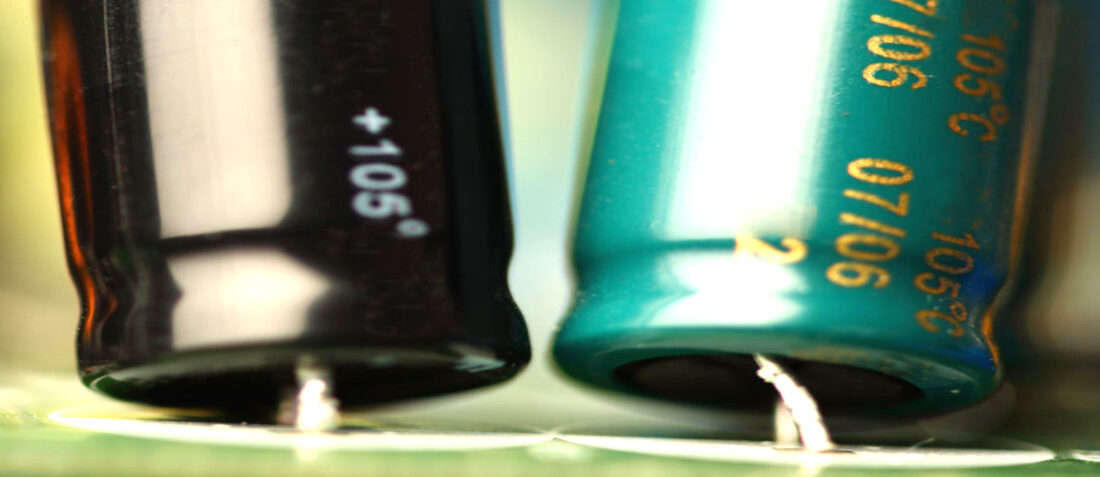
Understanding ESR in electrolytic capacitors
- Posted by doEEEt Media Group
- On July 8, 2020
- 0
Today’s microprocessor-based systems require power sources that deliver high current and ultra-fast transient performance, with tight regulation. This creates a need for cost-effective, compact capacitors with high capacitance values. Electrolytic capacitors are the solution of choice but it’s important to go beyond specifying capacitance and voltage to consider equivalent series resistance (ESR) as a figure of merit.
ESR: Easier to define than specify
The capacitor equivalent circuit comprises four elements (Figure 1, right): capacitance, equivalent series inductance (ESL) – the sum of inductive elements including leads, a high-resistance DC path (Rp) in parallel with the capacitance, and equivalent series resistance (ESR) – the series resistive effects combined into a single element.
ESR is frequency-dependent, temperature-dependent, and changes as components age. It is usually only important consideration in selecting electrolytic capacitors.
Constructing the capacitor
‘Wet’ aluminum electrolytic capacitors have an anode plate comprising an electrochemically-etched aluminum foil, a dielectric formed as an oxide layer on this foil, a paper spacer to hold conductive fluid that forms the cathode, and a second foil that connects the electrolyte and the device’s terminal.
Fluid-electrolyte penetrates the pores of the oxidized anode foil, so contact area, and hence capacitance, are maximized.
The electrolyte’s temperature-dependent conductivity is a major contributor to ESR. Ohmic losses produced by the aluminum oxide layer are frequency-dependent, reducing as frequency increases. Fluid-electrolyte is lost over time by vaporization and diffusion, causing a gradual reduction in the amount of conducting material, reducing the contact area, increasing the ESR and reducing capacitance.
This “drying out” process is temperature dependent and accelerates in components used at higher temperatures or subjected to higher ripple currents, which dissipate more heat as part of their circuit function.
In aluminum electrolytics, ESR falls as temperature increases – its effects reduce as assemblies warm up.
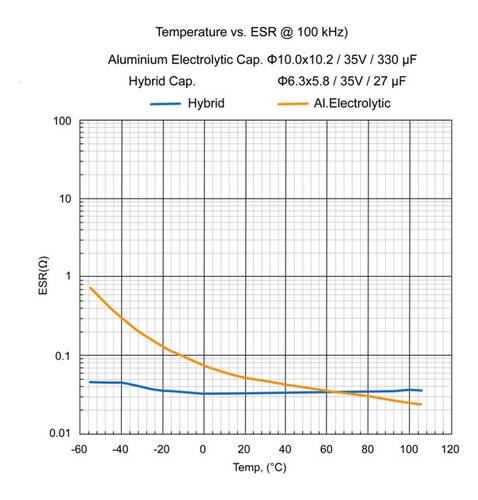
Drying out is irrelevant in solid aluminum electrolytics, or ‘hybrid’ capacitors, where a polymerized organic semiconductor material replaces liquid electrolyte. This technology exhibits a specific conductance of around 10,000 times that of a liquid electrolyte. As Figure 2 (right) shows, overall equivalent series resistance is reduced substantially, most significantly at low temperatures.
Tantalum technology
Tantalum electrolytics have tantalum anodes of either sintered powder or plain or etched foil. The insulator is an oxide layer on the anode surface. In foil devices, the second conductor is an electrolyte held in a spacer. A deposit of manganese dioxide covers the oxide layer in solid versions.
The component’s terminations are substantial contributors to ESR. In a solid capacitor, the manganese dioxide is commonly covered with carbon and then a metal such as silver, which is soldered to the negative lead or case. In the foil style, the positive connection is a welded nickel or steel wire connected to a tantalum wire on the anode. Such devices also contain a second tantalum foil in contact with the electrolyte.
At low frequencies, the oxide losses are most significant. But their contribution decreases inversely with frequency, eventually becoming small compared with the contact material resistance (Figure 3).
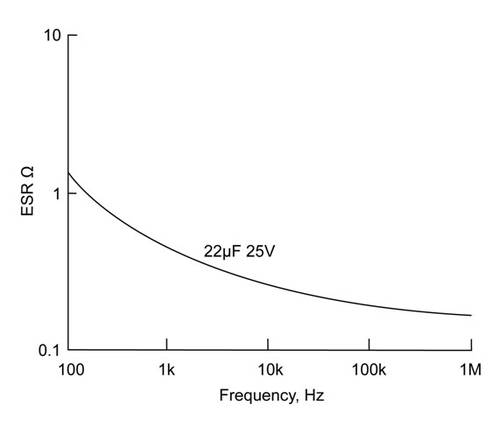
Figure 3: Typical relationship between ESR and frequency for tantalum capacitors (AVX)
Why is ESR important?
Electrolytic capacitors are used as input buffers to supply energy when the mains input voltage is too low, store energy while an AC/DC converter adapts to a new power level, and prevent switching noise from the converter reaching the power source. On the output of a converter, they act as a filter and current sink for inductive elements, and, in DC/DC conversion, function as an energy buffer when the power output demand changes.
In both cases, losses due to ESR will inhibit a capacitor’s ability to quickly source or sink charge. At the input, increasing ESR increases high-frequency noise across the capacitor, decreasing filtering effectiveness. At the output, higher ESR causes more ripple, influencing the stability of the control loop.
ESR is particularly important in applications with low duty-cycle, high-frequency current pulses. Here, the ripple voltage due to the ESR will be greater than expected based on capacitance alone, although the negative correlation of ESR with temperature means that ripple decreases as the assembly warms up.
Also, the introduction of a resistive element into what designers may assume is a purely reactive circuit can lead to unexpected shifts in phase response, again affecting stability.
What can be done?
Some capacitors are designed specifically for low-ESR, but manufacturers of aluminum electrolytic capacitors do not specify ESR consistently. The value at 25°C and 100kHz is commonly quoted, with a formula provided to calculate the value at the operating frequency. Some suppliers specify at 120Hz; others leave the designer to calculate the figure at the frequency of interest from the dissipation factor (tan∂) and specified maximum ripple current.
Furthermore, for capacitors of comparable size and CV, a device with higher capacitance and lower voltage rating will have lower ESR and ESR tends to be lower for aluminum electrolytic devices with long, thin cases because the resistance of the foil is reduced. Larger overall case sizes can cut ESR too.
Also, several smaller-value components can be used in parallel to achieve lower high-frequency ESR, at the expense of board space.
Other Advances
Several manufacturers of aluminum electrolytic capacitors have been combining solid and liquid electrolytes to produce hybrid components with ultra-low ESR (low tens of milliohms), with minimal temperature variation, while increasing withstand voltage and accommodating high ripple current.
As ESR varies with external surface area tantalum capacitor manufacturers produce multi-anode devices for high-reliability markets that may point the way to developments for more mainstream applications.
But low ESR is not always the primary consideration and, in a development outside of electrolytic devices, Murata has actually increased ESR of some of its multilayer ceramic chip capacitors, in order to control unwanted resonances that can reduce the decoupling performance at peak frequencies.
Source: AVNET ABACUS Engineers Insight
Written by Adam Chidley Avnet Abacus European Senior Product Manager
- Miniature RF Connectors - April 29, 2025
- Miniature RF Connectors for high-performance testing - April 24, 2025
- Space-Grade components available for immediate delivery - April 10, 2025

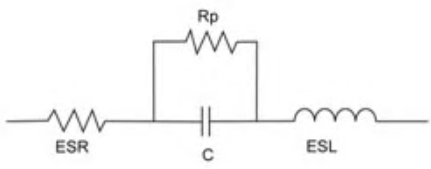
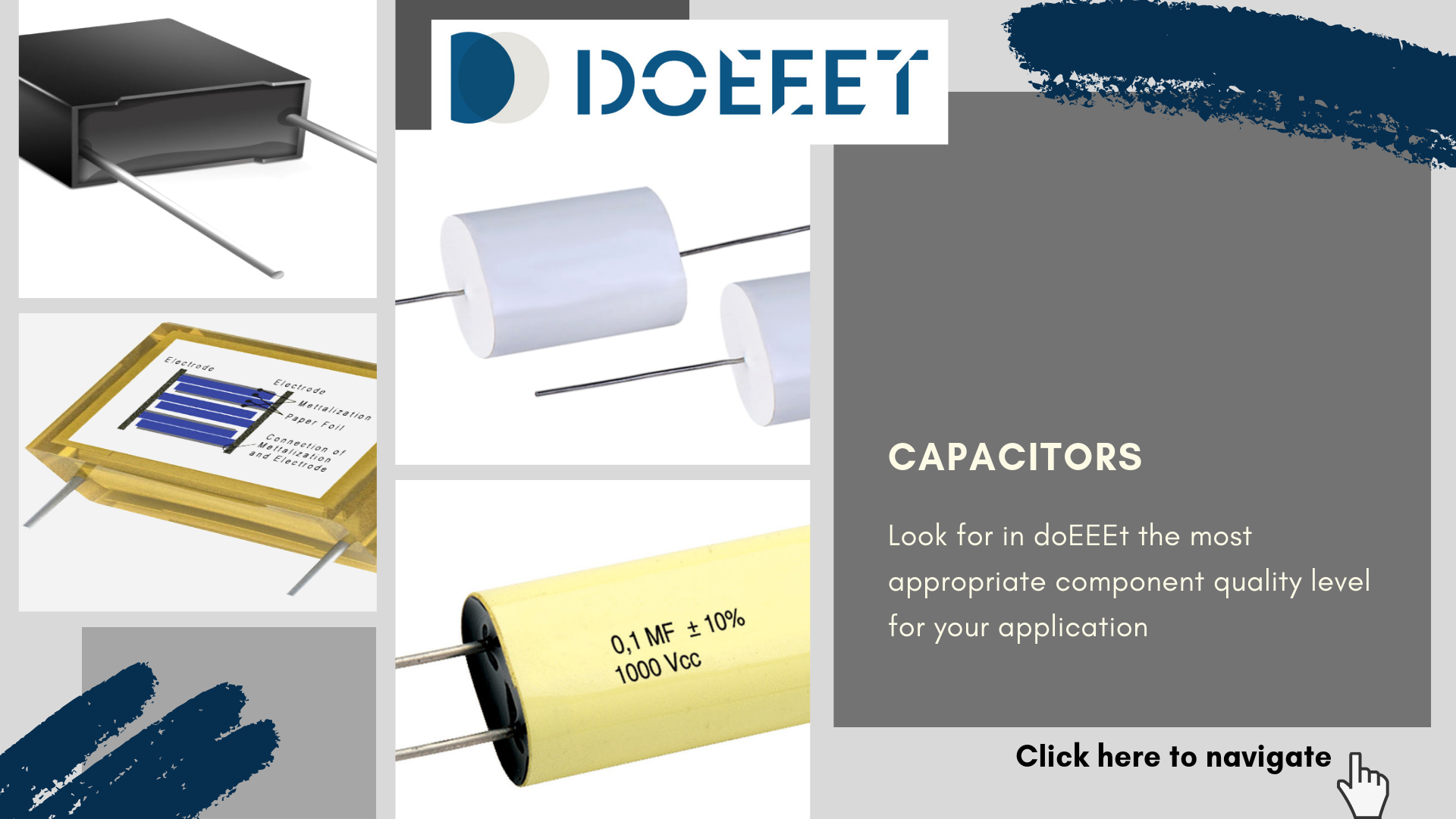
0 comments on Understanding ESR in electrolytic capacitors